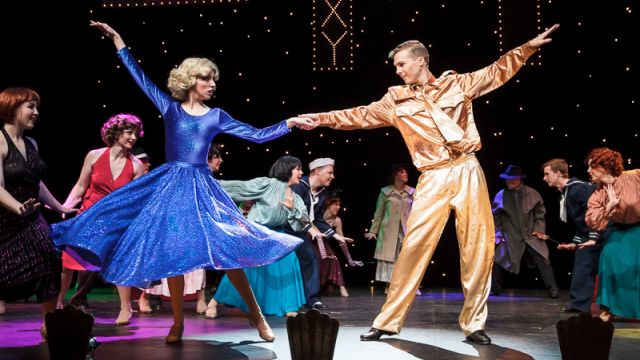42nd Street
From the first notes of the overture, the orchestrations of 42nd Street set the adrenalin of Broadway musical lovers pumping, and musically this production, under Mark Pigot’s expert baton, was stunning from the outset.
Musical comedy pure and simple, based on the Busby Berkeley Hollywood spectaculars of the 1930s, this 42nd Street is pure escapist entertainment.
The plot, Leading Lady breaks her leg during first run of a Broadway-bound musical, chorus girl steps in and becomes overnight star, provides the excuse for a string of extravagant song and tap dance numbers.
Peggy Sawyer, the overnight star, is nominally the leading lady, and Skye Roberts is a terrific tapper and singer, though the script leaves this ingénue role somewhat overshadowed by three more dynamic women’s roles.
As the supposedly faded Leading Lady Dorothy Brock, my only question is whether Susan Gavran is perhaps a little too good for the role. Are the descriptions of Brock as being past it mere backstage bitchiness? In this production we’re treated to a terrific all-round performance suggesting a performer in her prime.
 Bold and brassy, writer Maggie Jones gets some of the show’s best material, and Katherine Schmitt delivers a spot-on performance of a role that seems tailor made. Her timing is excellent, her portrayal strong and warm, and she absolutely delivers with the vocals. Vivacious Laura Sheldon shines in the lively role of Anytime Annie, the chorus girl played by Ginger Rogers in the movie, cheekily nailing this little comic gem.
Bold and brassy, writer Maggie Jones gets some of the show’s best material, and Katherine Schmitt delivers a spot-on performance of a role that seems tailor made. Her timing is excellent, her portrayal strong and warm, and she absolutely delivers with the vocals. Vivacious Laura Sheldon shines in the lively role of Anytime Annie, the chorus girl played by Ginger Rogers in the movie, cheekily nailing this little comic gem.
Only the millionaire sugar daddy’s dog manages to upstage this trio, for all the usual wrong reasons.
Roles in this musical comedy are generally theatrical archetypes, and male roles, including the juvenile leading man (Simon Thompson), the director (Jeremy Curtin), the sugar daddy (Warren Blood) and the leading lady’s secret lover (Scott Clare) are capably and confidently played, but the writing of these parts lacks the zing and sassiness which lifts their female counterparts to broad theatrics, and something beyond stereotype.
But what the hell – this is musical comedy after all, not Shakespeare.
 What I missed was a strong, distinct male tapping ensemble, a hallmark of previous professional and amateur productions I’ve seen. Sure female tappers slightly outnumbered the men in the original professional version, but here there were just a handful of male tappers, so out of balance with the large female ensemble when a line of girls stretching across the stage was partnered by just a couple of boys.
What I missed was a strong, distinct male tapping ensemble, a hallmark of previous professional and amateur productions I’ve seen. Sure female tappers slightly outnumbered the men in the original professional version, but here there were just a handful of male tappers, so out of balance with the large female ensemble when a line of girls stretching across the stage was partnered by just a couple of boys.
Splendid and gorgeous as Willoughby’s blonde-wigged, disciplined female tapping ensemble is, the sheer masculine quality of guys’ tapping, so different yet so complementary, can’t be replaced like the vocals are, bolstered by some great male pit singers. Lack of numbers here means the guys mostly seem to merge with the girls rather than being injected to provide that thrilling escalation they can add to a big routine.
Male tappers being scarce, director Janina Hamerlok and choreographer Natalie Neary might well have done better to consider an all-girl rethink of the big tap routines.
Costuming and wigs, co-ordinated by James Worner, were the visual treat, in a production where some sets were spectacular, though there were moments, as in the central platform for ‘Dames’, which seemed undercooked.
For 42nd Street first-timers and lovers of pure escapism, Willoughby’s production holds delights aplenty.
Neil Litchfield
Subscribe to our E-Newsletter, buy our latest print edition or find a Performing Arts book at Book Nook.

